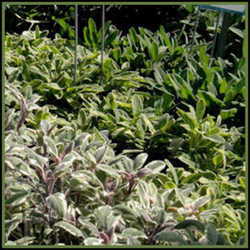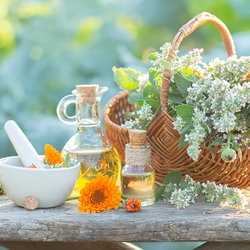Salvia comes from the Latin word salvare meaning to heal or save. Square stems and opposite leaves, each pair at right angles to the previous one, mark them as members of the mint family. Flowers with two lips of unequal length are borne in clusters (spikes, racemes or panicles), and range the gamut of flower colors, including blue, purple, coral, red, pink, white, yellow, and all colors in between. Both foliage and flowers have an incredible range of scents, some pleasant, and some otherwise. Regardless of the scent, hummingbirds and butterflies find them irresistible, and small birds feed on the seeds.
An easy identifier is the tubular or bell-shaped calyx (group of sepals around the outside of the flower that encloses and protects the flower bud). One side is longer than the other, and although it is usually green, some salvias have calyces the same color as the flower, while in others it is a contrasting color.
Growing conditions: Most salvias require well drained, neutral to alkaline soil, and full sun to part shade. The vast majority are drought tolerant and do well in hot, dry conditions. Remove spent bloom spikes to encourage continuous bloom. Do not over fertilize as most are adapted to poor soils. Avoid wetting the foliage as much as possible to prevent mold and mildew.
Hundreds of species and cultivars have been identified or selected. Some of the author's favorites are shown below. Mouse over the pictures for identification and picture credits.
 |  |  |
 |  |  |
 |  |  |
 |  |  |
Most people grow salvias for their long-lasting color in the garden. Some enjoy exhibiting the results of their efforts in Standard Flower Shows. Following the hints below will give exhibitors the best chance of winning a blue ribbon.
- Carefully clean upper and lower surfaces and make sure they are free of any debris. This is often tricky because many of the leaves have hairy surfaces that collect trash.
- Cut specimens early in the morning or in the evening when plants are well hydrated. Place cut stems in a container of water and allow them to stand overnight or for several hours. Add a floral preservative to prolong the life of the cut stem.
- Give the specimen a clean cut on the stem with a sharp knife before placing in the exhibit bottle.
- Carefully remove spent flowers and dead or damaged leaves, and any that will be below the level of the water.
Salvias can be exhibited as a flowering specimen (cut or container-grown), or they can be exhibited in a section or class for herbs. Some species, such as Salvia officinalis are grown primarily for their usefulness or as a seasoning herb. Such "useful" herbs can be shown without flowers since the leaves are the primary reason for including it in the garden.
Be aware of judges' expectations and select specimens that exhibit cultural perfection as much as possible. Judges will look for:
- blossoms that are fresh, not showing signs of overly mature pollen or limp flowers.
- stems that are sturdy and well clothed with leaves and side branches (according to type); stem that is proportionate in length to the number of leaf nodes and amount of attached foliage.
- spike forms that are erect and straight to the tip with the tip intact.
- the maximum number of flowers open on blooming stems. Usually about two-thirds of flowers are open and one-third are developing buds and flowers.
- form that is balanced with leaves and side shoots at regular intervals and positions on the stem
Whether you grow salvia for exhibiting in the flower show or for your own personal enjoyment or garden enhancement, you are sure to find some that will work in your garden. For summer-long color, the annuals work nicely. For color through the years, choose the perennial types. Some do not bloom throughout the growing season, but when they do bloom, the show is spectacular. In addition to attractive flowers, butterflies, hummingbirds, and other birds will frequent your garden if salvia is present.
Did You Know? The popular culinary herb that is referred to as sage is Salvia officinalis (common sage). It is available in cultivars that are attractive in the herb garden and in an ornamental flower border. Select cultivars are: ‘Tricolor' (leaves of green, white, and purple), ‘Purpurascens' (greenish purple leaves), ‘Aurea' (variegated green and gold), and ‘Icterina' (woolly, aromatic foliage with yellow and green variegation). When exhibited as a culinary herb, it is exhibited at its optimal stage for use. The presence of flowers would indicate that it was past the stage for optimal use as a culinary herb. |
Thanks to Dave's Garden members for uploading photographs of Salvia to Dave's Garden. They greatly enhanced my article. Mouse over the pictures for identification of the plants as well as credits to the following contributors: Htop, Marilynbeth, Lilylover, Happenstance, KMac, KevinMc79, growin |

















